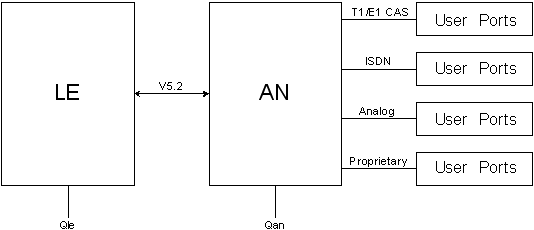
You are here: CSP Developer’s Guide: Common Channel Signaling > 10 V5.2 Protocol > Introduction

Overview
This section describes Dialogic’s V5.2 products, including the hardware and software required to run and manage V5.2 on the Converged Services Platform (CSP). This implementation supports only the Local Exchange (LE) side of V5.2.
This section has been created to help application developers correctly implement and manage V5.2 applications on the CSP. It describes the internal components of the V5.2 implementation that accommodate signaling, configuration, maintenance, startup procedures, and call processing.
The V5.2 implementation involves the E-ONE card and the ISDN Series 3 card, where the V5.2 protocol resides and functions, and where all of the signaling takes place. The C Channel information is internally routed to the ISDN Series 3 card from the E-ONE card.
V5.2 is a concentration protocol for digital Common Channel Signaling (CCS). It is called a concentration protocol because it can accommodate more subscribers than existing physical ports. The V5.2 protocol is comprised of the LE (Local Exchange) side of the protocol. The V5.2 protocol is used to establish, maintain, and release calls between an LE and an AN.
The V5.2 LE is the "network side" that resides at an End Office (EO) and provides the EO and Mobile Switching Center (MSC) functionality. This functionality includes additional CLASS features and services typically provided by an LE. The AN receives V5.2 data from the LE, then passes it to two-wire analog, ISDN, Frame Relay, Wireless, Fiber Optic, or any other Customer Premises Equipment (CPE).
V5.2 supports up to 16 E1s (2048 kbps) per interface. Residing on two of these links are primary and secondary C Channels (the equivalent of ISDN D Channels) and voice/data circuits. The C Channels are 64 kbps HDLC controllers that carry signaling information for various sub-protocols within V5.2. These sub-protocols manage call processing, startup, synchronization, maintenance, and C Channel protection. V5.2 has built-in link protection that permits calls to proceed when the primary C Channel link has failed. V5.2 supports PSTN and ISDN user ports. To maintain service when multiple V5.2 links are available and one link is lost, bearer timeslots are allocated dynamically. Even if individual calls are lost, they can be re-established on a different link when re-dialed.
The figure below shows the V5.2 protocol LE relationship.
Figure 10-1 V5.2 Protocol LE Relationship

• V5.2 for the LE side
• 16 interfaces per ISDN Series 3 card
• 16 links (E1) per interface
• 10,000 subscribers (user ports) per ISDN Series 3 card
• PSTN protocol, BCC protocol, Control protocol, Link protocol, Protection protocol, System Management, LAPV, and Envelope function
• Protection Group 1 C Channel pair
• PPL programmability for call processing and layer management
• Dynamic addition and removal of links (not allowed for primary and secondary C Channel links)
• Maintenance support for link blocking and unblocking
• The ISDN Series 3 card enables the DSP-ONE card to collect digits and play out tones.
V.52 redundancy is achieved through card-level redundancy on the ISDN Series 3 card. Refer to ISDN Redundancy to configure.
Summary
Below are the V5.2 Application Program Interface (API) messages, Address Information Blocks (AIB), and Information Control Blocks (ICB). Also listed are modified API messages used to implement V5.2 on the CSP. For detailed information on API messages, AIBs, and ICBs please refer to the API Reference.
• V5 Configure (0x7B)
• V5 Configuration Query (0x7C)
Existing Messages for V5.2 Configuration
• PPL Timer Configure (0xCF)
• PPL Configure (0xD7)
• PPL Assign (0xD1)
• PPL Create (0xD4)
• PPL Table Initiate Download (0xD5)
• PPL Table Download (0xD6)
• PPL Delete (0xDA)
• PPL Audit Configure (0xDC)
• Service State Configure (0x0A)
Existing Messages for V5.2 Queries
• PPL Data Query (0xDE)
• PPL Audit Query (0xDD)
• PPL Protocol Query (0xDF)
Address Information Blocks (AIBs) for V5.2
• V5 ID (0x2C)
• V5 ID, Link ID (0x2D)
• V5 Interface ID, User Port (0x2F)
Information Control Blocks (ICBs) for V5.2
• V5 Subscriber ID (0x28)
• V5 Formatted IEs (0x29)
• V5 User Port Range (0x2C)
• V5 Statistics Query Data (0x2F)
• V5 Statistics Data (0x30)
• V5 Status Indication (0x31)